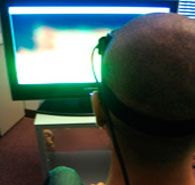 The new pIR3 is a passive infrared sensor device for biofeedback. Three infrared sensors are mounted in the plastic housing that sits on the forehead and is attached with an adjustable band around the head. Since we are looking at signals from left, right and center, it is important to place the device appropriately so that the label is right side up and the cable extends from the right side of the device. The infrared sensors are not in contact with the forehead, but are held at some distance away so they can measure heat that is radiated from the head. It is important to seat the housing securely (stably) just above the eyebrows. If any hair falls between the forehead and sensors, the signal will be diminished and also more variable, so care must be taken to move any hair out of the way.
The new pIR3 is a passive infrared sensor device for biofeedback. Three infrared sensors are mounted in the plastic housing that sits on the forehead and is attached with an adjustable band around the head. Since we are looking at signals from left, right and center, it is important to place the device appropriately so that the label is right side up and the cable extends from the right side of the device. The infrared sensors are not in contact with the forehead, but are held at some distance away so they can measure heat that is radiated from the head. It is important to seat the housing securely (stably) just above the eyebrows. If any hair falls between the forehead and sensors, the signal will be diminished and also more variable, so care must be taken to move any hair out of the way.
The pIR3 follows the lead of Jeff Carmen, who has worked extensively with pIR HEG biofeedback, primarily for migraine headaches. Jeff’s work has used a single sensor for feedback, which is typically placed at Fpz. The pIR3 provides three sensors at approximately Fp1, Fpz and Fp2, and hence the ability to combine the signals as desired for feedback purposes. The pIR3 plugs into any of the three peripheral device inputs on the front of the Neuroamp. BioExplorer software displays the signals and Particle Editor provides additional feedback information and reward. (more…)

 Updated BioExplorer designs are available at
Updated BioExplorer designs are available at